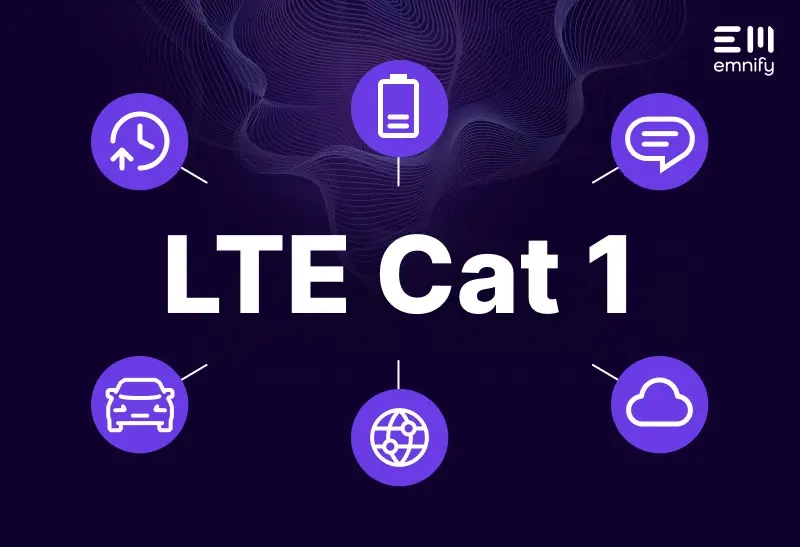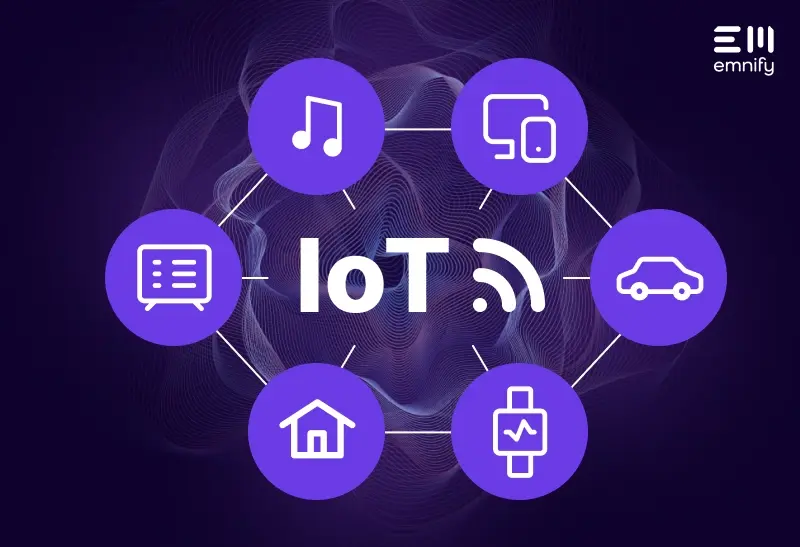

Table of contents
- The shift from wired to wireless POS connectivity
- The limits of Wi-Fi POS connectivity
- The advancing cellular landscape
- Cellular + Wi-Fi: New options for POS devices
- Making a good thing even better: Multi-network cellular connectivity
- emnify: Tailored POS connectivity for your needs
For retailers worldwide, a reliable and secure point-of-sale (POS) system is critical for running their businesses effectively. Traditionally, devices for processing retail charges relied on wired connections like Ethernet to communicate sales data and authorize payments to credit card companies or banks.
However, advances in wireless technology have liberated retailers, allowing POS devices to go mobile and enabling new levels of flexibility and convenience. This mobility opens the door to innovative business models and enhanced customer experiences. Despite the convenience of wireless POS systems, connectivity issues can still pose significant challenges.
To address this issue, wireless POS systems are evolving to support both Wi-Fi and cellular connectivity. In particular, multi-network cellular connections are bringing unprecedented reliability and flexibility to mobile and remote payment systems.
The shift from wired to wireless POS connectivity
For decades, wired POS network connectivity has been the standard. While reliable, they come with some significant limitations. Running Ethernet or other wired connections requires labor-intensive installation and locks the POS terminal to a fixed location near a local wired network router. Imagine being tethered to a spot, unable to move freely—hardly ideal for dynamic retail environments.
Enter wireless POS systems. With no cables to worry about, retailers can place POS terminals wherever they’re needed most. Whether at a busy checkout counter or with a mobile cashier, payments can be processed right where the customer is.
Retailers can also quickly set up temporary on-site POS devices for pop-up shops, food trucks, or events. With wireless connectivity, businesses also have the option to use purpose-built handheld POS devices or POS applications running on smartphones and tablets. The flexibility and mobility unlocked by wireless POS translates into a better overall customer experience and new revenue opportunities for retailers.
The limits of Wi-Fi POS connectivity
The first wave of mobile and remote POS systems relied on Wi-Fi connectivity. This readily available and relatively inexpensive networking option can provide reasonably dependable connectivity within a fixed area, such as inside a store, but Wi-FI connectivity for POS devices has several limitations.
Interference and reliability issues
Think about Wi-Fi signals as delicate threads weaving through your store. These threads can be easily tangled by walls, industrial equipment, or even other devices operating on the same frequency. This can cause connectivity dropouts and failed transactions, leading to lost revenues and unhappy customers.
Security vulnerabilities
Public Wi-Fi networks are like open doors with flimsy locks. Unlike the strong encryption of wired or cellular networks, public Wi-Fi is susceptible to rogue access points and man-in-the-middle attacks. This can potentially expose customer payment data, compromising trust and security.
Bandwidth constraints
As more customer devices flood retail Wi-Fi, allocating sufficient bandwidth for POS terminals can be an issue, especially at large events. Applications like video surveillance can also consume necessary bandwidth for POS devices sharing the same Wi-Fi network.
Coverage limitations
Wi-Fi signals are limited to the physical range of hotspots/routers. Building walls or interference from other devices or equipment can greatly limit the range of a Wi-Fi signal, creating dead spots in coverage and requiring more equipment to boost signals for adequate coverage.
The advancing cellular landscape
Early generations of cellular networks like 2G and 3G lacked the speed, bandwidth, reliability, and security to make cellular POS systems a viable option for most retailers. But that has changed with recent advancements in 4G LTE and 5G networks.
4G LTE provides the bandwidth, speed, and low latency required to process payments, upload sales data, and perform other POS functions wirelessly. It supports a wide range of certified POS hardware from leading providers like Verifone, Ingenico, and Clover. Many large retailers have already adopted 4G for their POS and mobile point-of-sale needs.
Looking ahead, 5G is set to take wireless retail even further. With even higher speeds and reliability, 5G will make wireless POS transactions even more seamless and dependable, effectively closing any performance gaps compared to wired connections.
Cellular + Wi-Fi: New options for POS devices
Advances in cellular services are helping retailers overcome the traditional limitations of Wi-Fi for payment systems. Here are some key improvements:
Ensuring dependable payments
Network outages and interruptions can grind retail operations to a halt if POS systems go down. Embedding a cellular SIM card in wireless POS devices ensures automatic switching to 4G/5G during a Wi-Fi disruption. This backup connectivity minimizes failed transactions and lost revenue.
It's not just local Wi-Fi outages that can impact POS connectivity. Retailers also face the risk of Internet or wide-area network failures that would prevent payment processing. Cellular connectivity sidesteps this vulnerability by operating on a separate, redundant broadband network from the retailer's primary Internet connection.
Extending the range for wireless POS
While Wi-Fi signals are confined to the limited radius around access points, cellular POS provides untethered connectivity to all outdoor areas surrounding a retail location. This is ideal for curbside/parking lot pickups, food trucks, outdoor mall kiosks, and remote seasonal events or pop-ups.
Critically, cellular networks utilize lower frequencies that better travel through building walls, reducing Wi-Fi dead spots and avoiding the need for costly signal boosters.
Securing payments
The built-in security of modern cellular networks like 4G and 5G is also a critical advantage over earlier wireless technologies. Cellular networks use robust end-to-end encryption, strict identity verification, and access control measures.
This protects sensitive payment data and other retail information as it travels wirelessly from POS devices to backend systems, making it much easier for retailers to comply with PCI data security standards.
Creating new models for remote payment systems
Cellular connectivity also provides a much-needed option for supporting payment processing in remote locations, helping businesses avoid the costs and hassles of maintaining their own connectivity networks.
It is particularly valuable for self-serve vending machines, unattended micro markets, mobile ATMs, parking management systems, and electric vehicle (EV) charging stations.
These services have many low-revenue kiosks that aren’t practical to support with Wi-Fi or wired connectivity, given the install and ongoing maintenance costs per unit.
Making a good thing even better: Multi-network cellular connectivity
Cellular services offer mobility, security, bandwidth, and coverage by connecting critical POS processes directly to a carrier network, free from the limitations of Wi-Fi. Upgrading to 4G/5G cellular for POS enables retailers to transform the customer experience through innovative wireless applications.
Even for retailers who use Wi-Fi as their primary network for in-store POS connectivity, adding cellular into the mix introduces crucial backup redundancy and extended range capabilities.
However, no network is infallible. High-density usage at events like concerts or unexpected network outages can impact even cellular-dependent POS systems. Dependability remains a vital concern.
Fortunately, new innovations now enable POS devices to connect to multi-network cellular services, including satellite networks, to provide essential connectivity redundancy. This ensures payment transactions happen without fail.
This innovative connectivity option requires a special SIM card for each POS device that connects to a multi-network service provider. With the SIM, the device can easily switch between cellular providers in case of network failure or limited bandwidth.
Additionally, the best new multi-network services can provide detailed network and device information, helping retailers and other services remotely identify performance issues or device failures.
emnify: Tailored POS connectivity for your needs
At emnify, we recognize that your IoT business is as unique as the innovative solutions you bring to market. That's why we don’t offer generic connectivity solutions. Instead, we partner with you to design, plan, and configure connectivity that meets your specific KPIs and operational needs, ensuring you deliver an exceptional customer experience.
Our IoT SuperNetwork provides the industry’s most comprehensive global coverage and industry-leading uptime with access to 540+ cellular and satellite networks, all from a single SIM. Our network’s versatility and reliability mean you can focus on what you do best—innovating and growing your business.
emnify delivers out-of-the-box connectivity for your point of sale terminals, so you can control costs, reduce complexities, and improve the efficiencies of your retail operations and payment processing.
Visit our POS solutions page to learn more about how emnify provides reliable, real-time IoT connectivity for all your retail payment processing needs.
Get fresh insights delivered straight to your inbox
Don't miss out on the latest industry trends, best practices, and insider tips for your marketing campaigns.

Charles Waltner
Charles Waltner is a former business journalist turned technology executive. He has deep experience in the communications, networking, and IoT markets.



